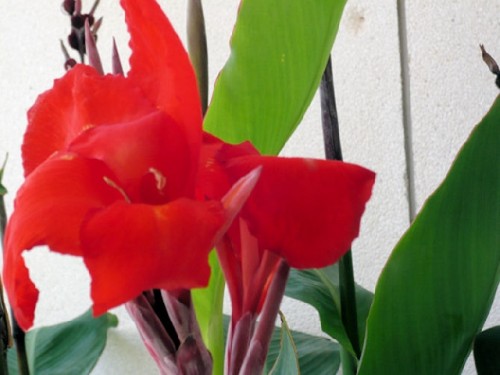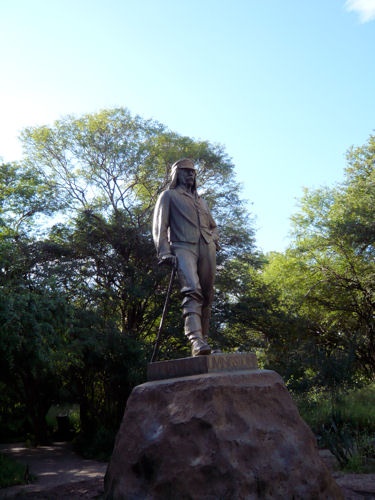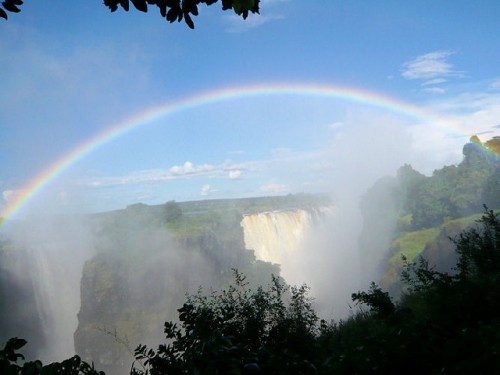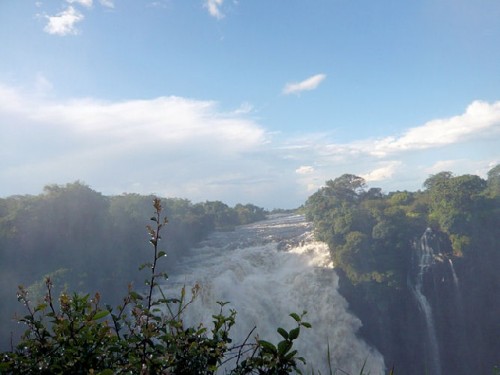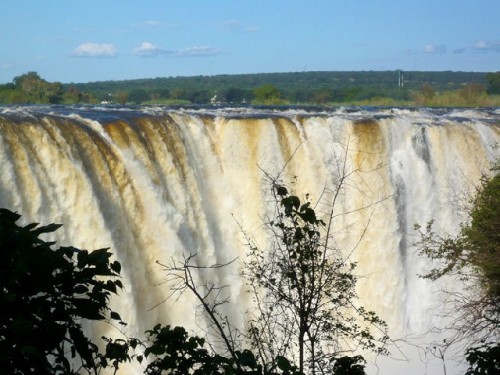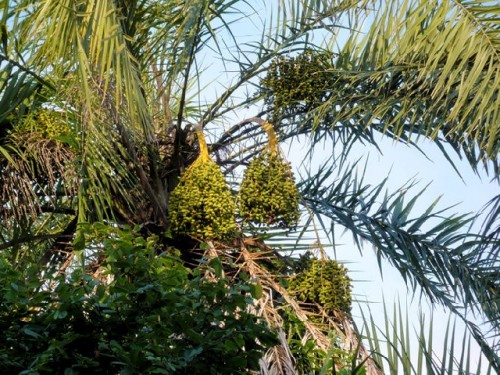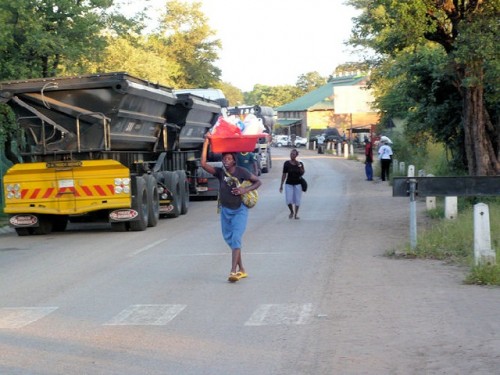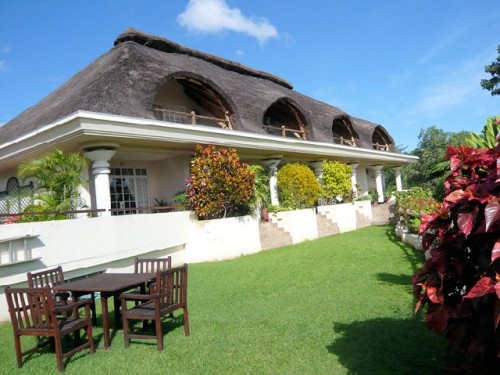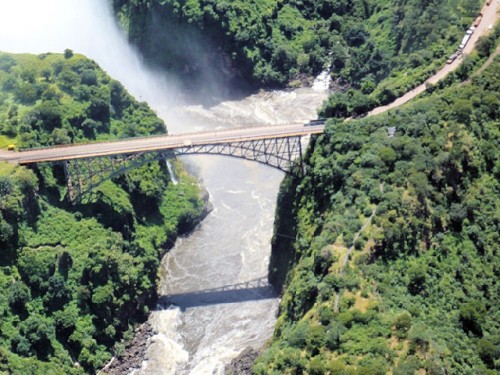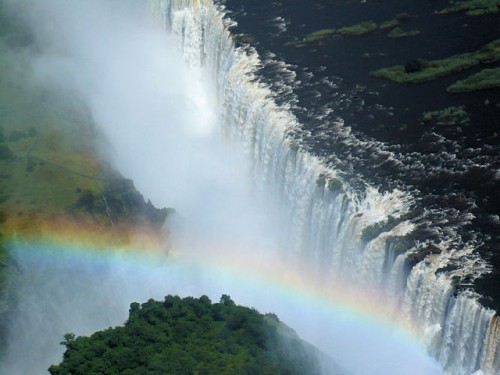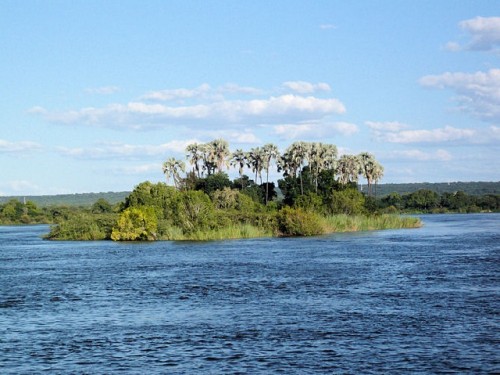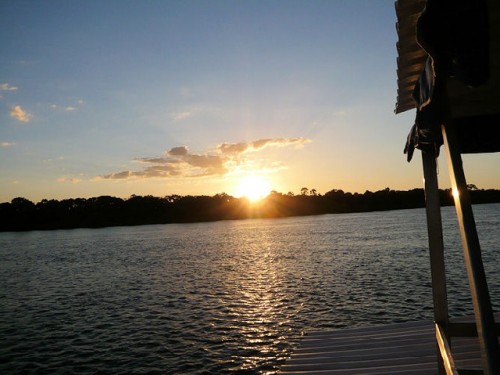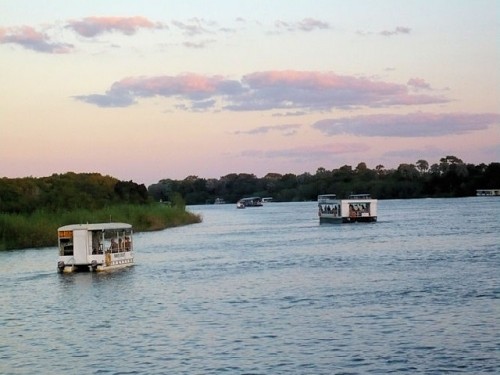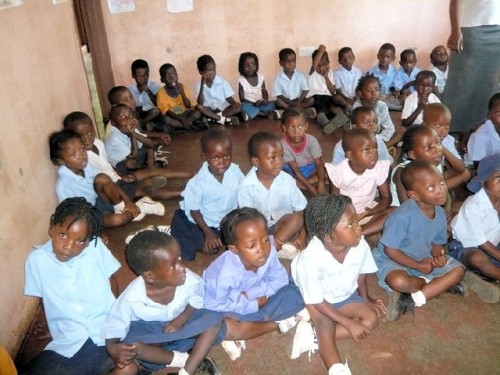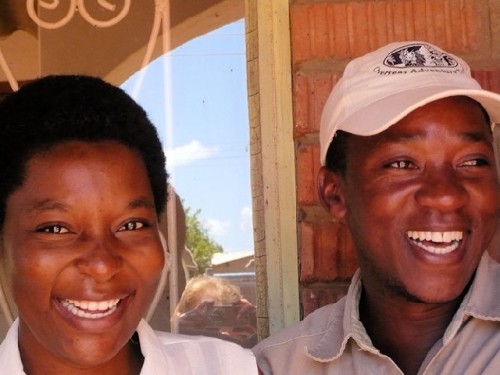Reports on Southern Africa: Part Five
Victoria Falls: Zimbabwe
By: Zeren Earls - Apr 08, 2008
During our flight to Victoria Falls, I volunteered to sit next to the pilot, as our group had been taking turns. My first time in a pilot's cabin, I expected action; instead, it felt like being in a car on cruise control. During the hour long flight, I gradually turned my gaze from the radar screen to the lush scenery below and began taking pictures. I continued shooting upon landing attracted by the bright red flowers, called launa, at the airport.
At the Ilala lodge, we were welcomed with passion fruit cocktails. Although still charmed by the shaggy reed roofs of Ilala, having spent two weeks in the bush, I was ready for its swimming pool and manicured grounds. After taking some time to unwind, we left for the actual falls by minivan. We could hear the cascades thunder from a distance, in fact, the falls' African name, Mosi-oa Tunya, means "the smoke that thunders". The Zambezi River, which is straddled by Zimbabwe and Zambia, forms the world's largest curtain of water at the falls. It is as high as the Niagara Falls and one-and-one-half times as wide. At peak flood times 1.4 billion gallons of water per minute pass over its edge.
The Zambezi River had flooded a month before we arrived, so the natural wonder was at its mightiest. The rain slicker I purchased online from Amazon came in handy for this wet exploration as we wove through the rain forest, in and out of walking trails and lookout points, each with different views. The rainbow etched in spray, rising from the crashing waters into the chasm created beautiful panoramas, although they were a challenge to photograph while keeping cameras dry. Of the five main cataracts, the Main Falls and Devil's Cataract were the most dramatic. Fed by Victoria's perpetual spray, the flora around was equally beautiful. Lianas, blood lilies, ferns, orchids, ebony, mahogany and fig trees shared the forest with birds, butterflies, monkeys and small buck.
The evening's buffet dinner on the patio included both familiar and exotic fare. Onion soup, a variety of cold appetizers, including dried tomatoes in balsamic vinegar and crocodile salad, were followed by a choice of main dishes, such as roast beef, grilled tilapia, warthog, stir fried vegetables, roasted potatoes and pasta. The dessert buffet was a sampler of warm apple cake with sauce, chocolate mousse and fresh fruit.
The following day we had a variety of optional activities to choose from, including bungi-jumping off Victoria Falls Bridge. I opted for the helicopter ride over the falls, the Livingstone Museum tour across the border in Zambia and the sunset cruise on the Zambezi River. The helicopter ride, although only 12 minutes long, provided breathtaking views of the great tapestry below: green-white water compressed into the gorge, dripping rock faces, billows of spray, rainbows and jungle all around. Our pilot flew close to the ground so that we could see the river's journey to the edge over a platform of black basalt, gathering momentum before it cascaded down. As the helicopter circled over the falls, we were able to enjoy a bird's eye view of the rain bowed sunlight, penetrating the heavy mist over the gorge across the lush forest.
Shearwater Adventures, organizers of the optional tours, cancelled the museum tour, because the cost for a Zambian visa had gone up from $10 to $70 and for a three-hour visit this was an excessive price to pay. The museum would have offered anthropological and cultural insights, in addition to comprehensive information on Dr. David Livingstone, a legendary man in Africa's history. Instead, I spent the afternoon in the open market, a colorful mayhem of vendors, pleading to sell you something so that they could eat.
Bartering or bargaining was expected here. The inflation rate is more than 100,000 percent, so an American dollar goes a long way. Despite the overwhelming experience of such poverty amidst plentiful kitsch, there were enticing handcrafts: Shona stone and wood carvings, textiles and basketry. I managed to buy a table cloth, a few carved items and a charming folk painting of hippos in the water for my grandchildren's bedroom.
The Sunset cruise was yet another memorable experience. We spotted crocodiles and hippos in the water, lizards on trees and vultures in the air. As soon as somebody in the group exclaimed, "Hippos!" there was a surge toward the rail. "There! There! Black shapes with lots of foam." One of the hippos broke the surface. Cameras clicked away. People took photographs of one another. An island, home to a grove of palm, poked up on the surface of the river. A little cove drifted past, trees growing right to the water's edge. Other cruise boats appeared to witness the sun's changing colors as it magically disappeared into the night sky.
Early the next morning we had a lecture by Mr. Washington, an authority on David Livingstone, the Scots-born missionary explorer, who lived in Zimbabwe for thirty-seven years during the time of the slave trade. This was a lucrative business for the chiefs, who ruled the land. While chiefs conquered each other's tribes, they also met 70% of the European and 30% of the American demand for slaves. Ninety-nine percent of the people had no rights; women were not given any choice.
Dr. Livingstone came from a poor family, had trained as a physician and also studied theology. He was 27-years-old when he came to Zimbabwe and initially lived in a 14 by 10 foot tenement building. During his many years in southern Africa he set up two missions, one of them in Botswana. He spoke fifteen African native languages and translated the Bible into Setswana. He also recruited volunteers for his expeditions and was welcomed by all tribal chiefs. He converted many from a traditional way of life to Christianity. At this time, Zambia had the most important chief, and became the country with the largest Christian population.
During one of his expeditions Dr. Livingstone came upon the natural wonder of the falls and deemed it to be a scene "gazed upon by the angels in their flight". He made the waterfall famous in the Western world by naming it after Queen Victoria in 1855. There is a bronze statue of him, with a purposeful gaze over the waterfall. He is glorified as a person who inspired by personal sacrifice; he was mauled by a lion and traveled by oxcart for three months to get treatment. He was the first person to use quinine; he lost his wife to malaria. He was committed to ending the slave trade, which became a reality in 1879, five years after his death. Dr Livingstone died of malaria and is buried in Westminster Abbey, although it was later discovered in his will that he had wanted to be buried in Zimbabwe. After deliberations following independence, it was decided to leave his statue standing in Zimbabwe and his body resting in Westminster.
During some free time following the lecture, I decided to explore the neighborhood. Across the way from our lodge was the casino, a state-of-the-art building complete with blinking lights, luxury shops but no customers. A walk through a park of lawns and huge trees led me to the Edwardian railway station where trains arrive from Cape Town. After a short tree-lined walk from the station, I arrived at the chunky orange-tiled Victoria Falls Hotel. Built in 1904 and refurbished many times, this luxury hotel had an impressive courtyard, patios, colonnades, huge trees and views over the falls and bridge. There were very few guests around to take advantage of its white-gloved ambience and superb setting.
Victoria Falls Village, half a mile back, was a world apart from the protected parkland of the hotel. A bustling place during good times, the village shops with quality goods had no customers; but hungry men hung around outside their doors trying to sell trinkets. To avoid the street vendors, I walked in to find several people eager to wait on me. I was happy to give them some business: bought a batik shirt, a beaded necklace and a small beaded pot. Beadwork is a specialty of Ndebele people. Then I strolled over to the Women's Craft Market. Women, many of whom are HIV positive, sat behind rows of crowded stalls displaying their hand-made items: crocheted bedspreads, table cloths, batiks of every size and color. They seemed willing to barter for anything. I bought yet another batik cloth from a young woman, who clearly did not look well. I knew that the $20 she received from me would at least buy her food from Zambia.
On our way to the airport we stopped by Tip-Top Smiles pre-school, owned and run by Mado, our trip leader and his family. His older sister and wife taught four and five year old children from low-income families. The children ate at school with food purchased in Zambia. Mado himself, who had seen hard times, was happily taking care of others now. As a boy, who grew up in the bush, he was not accepted by any city school, with the exception of one run by Seventh Day Adventists. That is where he met his wife. Later his training as a car mechanic led him to a job as a safari driver, which then qualified him to be a guide because of his strong command of English and broad knowledge of the bush.
On our way to Johannesburg for our post-extension trip to Cape Town, we hugged Mado goodbye, wishing him and his beloved Zimbabwe good luck with the much anticipated upcoming elections. Although the elections have taken place since then, the results have not been revealed yet. Mugabe, at the age of 84, is still looked upon by some as the hero of the nation's struggle against white rule. He has become deeply unpopular, though as the economy has imploded. He is reluctant to step down, although the opposition party claims victory. There may be run-off elections, which I hope will allow a regime change without violence. Zimbabwe is a beautiful country with much potential to be Africa's bread basket with its verdant lands.

